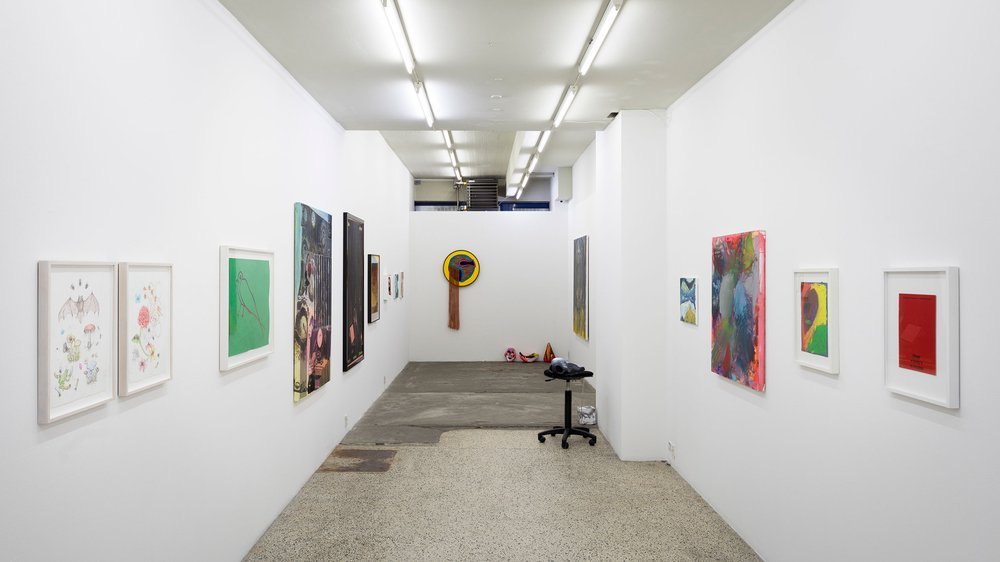Directing Narratives by Combining Words with Paint.
*Archive Article: Originally published in the magazine Blacklisted Copenhagen on November 6, 2018
With the recent release of our first print magazine issue, and all the research that went into its curation of artists, I have recently become fascinated with artists that use text within their work.
To backtrack a little, the premise of our recent issue deals with this exact subject. In fact, we partnered with US social media platform Ello to hold an artist invite with these parameters: “Looking for artists that use text as a medium, research or concept for their artistic output.”
We got hundreds of submissions, and we had to whittle that down to a short list of artists to spotlight. One such artist is the UK based contemporary artist Simon Kirk. His integration of text within his paintings is more direct in contrast to some of the more representational and conceptual uses that we selected, but that is not to say that it is less impactful.
What drew me to Kirk’s work is that by sparsely using lines of found text into his collage-like paintings, he was able to direct the narrative of his paintings more than usual. To clarify, visual arts typically use composition, form, and subject matter to drive narrative meaning in a work. But, a viewer’s interpretation of that work is highly subjective depending on that specific composition, form, or subject matter. In other words, different people will impart different meanings or importance, depending on their viewpoint.
With Simon Kirk’s work, he narrows that subjectivity with the implementation of words, statements, and text.
Now his works don’t directly tell you what to see and think – that would be a fairly mundane work of art. But rather, his work exposes a specific story path. Because text is such an integral part in the way we, as humans, tell stories, we can inherently respond to it in a common way.
There is a whole field of study called Memetics which is currently looking into the phenomena which mirror the same primary responses that Kirk’s work can spark – internet Memes. How images paired with a statement or line of copy can elicit an emotional response.
INTERVIEW
With your implementation of copy, collage, and paint, each of your works creates such a visual narrative for me. Tell me about how you developed this style.
When I was younger, I was predominantly a traditional figurative painter. It was when I went to art college and then onto university to study Fine Art that my style began to evolve. I discovered the work of William Burroughs and started introducing text into my work, which then evolved into incorporating elements of collage.
However, while I was entirely comfortable working in sketchbooks, I couldn’t seem to replicate the freedom and spontaneity onto my wall pieces. It was a wrestling match throughout my university years and for some years beyond. I had all the elements of my work in place, the things that would inspire me going forward, but I couldn’t find a way to translate them into works for exhibition.
I began to find my style by working on my pieces as I would a sketchbook. I built up layers of paint and collage, painted areas out and ripped bits off. I echoed the editing process that would take place in a sketchbook but the ideas were developing, and the decisions about composition were all taking place on the pieces themselves.
I compare it to learning an instrument in so far as you can’t express the music in your head if you don’t learn the mechanics first.
Because you often choose to use text in your work, do you approach each work with a specific story to tell?
I don’t have a specific story to tell until the work begins to develop. Because I’m building up layers and layers there’s a certain element of play in the early stages of a piece. As a piece progresses I start to develop a narrative I want to pursue. I begin planning what I will do based on what juxtapositions of text and collage I can see in the boxes around me. It can be a memory game; this piece of collage would be perfect for this piece… now, where did I see it? But other times it happens in seconds – images and text collide and create observations that I wasn’t expecting.
We live in non-linear times – we can watch TV, communicate, read, listen to music, and shop, in such a short space of time with minimal effort in a way that was impossible twenty years ago. I’m trying to imitate this by condensing the information into the work and seeing what connections are made.
Of the found elements that you use in your work, where do you find the material?
Found images I mostly collect from vintage magazines and old newspapers from eBay, second-hand shops and boot fairs. I also harvest my own drawings from sketchbooks, sometimes going back years through books I had stored and forgotten about. I’m very much a magpie, constantly collecting ephemera. The texts are cut from pages of novels. I scan through the prose to find poems or phrases by linking words from sentences. However, rather than cutting out words or strips of words and re-arranging them randomly, in my variation of the cut-up technique I must be able to cut the ‘poem’ I create out in one section – it functions as a collage piece in itself. I am using what is on the page but distorting the sense through my editing. The cut-ups subvert existing texts into something manic and fierce or poetic and evocative.
The beauty of combining unrelated images and text is that the resulting narrative is always greater than the sum of its parts. People bring their own experiences and associations and make their own connections.
Take me through a day of work in your studio?
I’m very much a night person but I tend to (unfortunately) wake fairly early, around 8 am usually. I’ll make some coffee and then turn on my PC. The mornings I use for admin and preparation. I’ll read emails, look through Instagram and Twitter for anything that interests me. I’ll upload work across all my social media, take photos or scan work, cut collage and look for cut-ups in novels, prepare whatever I need for painting later.
I often have to pack work and order couriers so that is a morning job too. Around 1 pm I’ll go for a snooze, so before that, I’ll ensure anything that needs to dry for later is completed – pasting layers, priming boards etc.
After 3 pm I’ll get into the studio to work. I like to keep a constant supply of influences playing: music, film, television, radio. Musically I’m naturally drawn to lyricism so I like storytellers like Tom Waits or Nick Cave. I’m a big fan of Public Enemy. When they started the technology didn’t exist to achieve what they wanted, so they improvised by joining tapes by hand and winding them around microphone stands to make big loops. The music itself was also a sculpture, running around the studio like a multi-layered musical collage; being able to visualize the way music ‘looks’ really appeals to me as an artist. Film-wise, I like those films that don’t have a linear plot, like David Lynch films for example. You recognize all the scenarios, you can understand the language and you almost know what’s going on, but not quite. It’s open to interpretation.
I’ll work through until around 12 am then call it a night.
Your work has garnered quite a bit of recognition throughout buyers and galleries, would you have any advice to other artists that might be inspired by your career as an artist?
I started by taking every opportunity that I could find. I did a lot of art fairs in the beginning. I always enjoyed the art fair environment; speaking to other artists, meeting buyers. It was here I began to forge contacts with galleries to further my career.
I would definitely say that once you have a gallery, be professional and respect the person who will be working hard to raise your profile and your prices. We have the benefit of the internet now which is invaluable. Artists can now work outside the conventions of the gallery system and the traditional art market and make their own sales to people all around the world. With that in mind, it’s so important to keep to the prices that have been established. Don’t devalue your own work by selling it cheaper to clients direct.
Remember it’s not enough just to do the work; you need to promote the work too. I don’t leave all the promotion to galleries, I can effectively promote myself too. Whatever important developments in your career occur, make sure you let people know!
Lastly, it may be a cliché but I believe in the power of a good positive mental attitude. Do not be put off by rejection, you will definitely need a thick skin and plenty of optimism.









